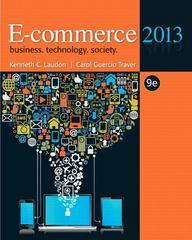Question
Some good strategies for this assignment would be to use real-world examples to illustrate the economic concept/topic; show how your economic concept/topic helps to explain
Some good strategies for this assignment would be to use real-world examples to illustrate the economic concept/topic; show how your economic concept/topic helps to explain more easily another, more difficult economic concept/topic; show how your economic concept/topic logically relates to some other economic concept/topic;
The concept/Topic I choose :
Technological Change
The forward progress of technology and science is the primary force for economic growthnot just in the United States, but everywhere. From the development of the steam engine, the automobile, and electricity through the creation of computers and the internet, technological change has been the critical factor in raising living standards.
Technological change, broadly speaking, is any improvement in the knowledge that increases the quantity and range of goods and services the economy can deliver. One example of technological change is the introduction of a new electronic product, such as the first microprocessor or the first mobile telephone, that lets people do things they couldn't do before (see the "Economic Milestone" box). Other examples of technological change include the expansion of online shopping, the development of cures for diseases such as Hepatitis C, and the testing of "self-driving cars," otherwise known as autonomous vehicles.
The term "technological change," as economists use it, also applies to new ways of organizing work. For example, in the 1950s, McDonald's became immensely profitable by adapting assembly-line methods to the restaurant industry. The result was "fast food" mass-produced at low prices. The technological change includes creativity in entertainment as well. Walt Disney, who died in 1966, created the animated feature film. Originally hand-drawn by teams of animators, those early films evolved into the computer animation we know today. Early video games, too, represented a form of technological change.Electric scooters, now found in many cities, are an interesting example of technological change transforming mobility.
Ray Kroc, founder of McDonald's
Bettmann/Getty Images
Successful technological change or innovation is much more difficult than it looks. Plenty of ideas look promising at first, but they take years or decades to get turned into successful products or businesses. For example, the first video telephone, which allowed you to see the person on the other end of the call, was demonstrated at the 1964 World's Fair in New York City. This was the AT&T Picturephone, and it was a commercial failure. It wasn't until many years later that videoconferencing became availablefirst, for businesses, and then for individuals through programs such as Skype and FaceTime.
Most products take multiple attempts to become practical. For example, the Apple iPhone was introduced in 2007. Before that, mobile phones could be used to talk with other people, but they had far less usefulness in terms of downloading information, entertainment, or games.
Technological change is uneven, moving much faster in some industries than others. Although information technology has evolved rapidly in recent decades, the pace of change in energy technologies has been much slower. Despite the rise of electric cars, the great majority of vehicles sold in the United States are still powered by internal combustion enginesa technology first invented in Germany in the 1880s. Nuclear power has turned out to be far more expensive and troublesome than expected, and the 2011 disaster at Japan's Fukushima nuclear power plant has raised more questions about safety. Meanwhile, renewable energy sources, such as solar, wind, and hydropower, provided only 11 percent of U.S. energy needs as of 2018.
However, with global climate change on everybody's minds these days, and the price of oil so high, companies and governments have more incentive to invest in developing new energy technologies that either are cheaper or emit fewer greenhouse gases. As a result, the pace of energy-related technological change may accelerate.
ECONOMIC MILESTONE
1997: THE FIRST TOYOTA PRIUS
In 1997, Japan-based carmaker Toyota introduced its innovative Prius model in Japan, which came to the United States in 2000. The Prius was the first mass-produced hybrid vehicle, combining both gasoline and electric propulsion systems to achieve higher gas mileage with less pollution. The Prius set the stage for fully electric vehicles, such as the ones made by Tesla.
Step by Step Solution
There are 3 Steps involved in it
Step: 1

Get Instant Access to Expert-Tailored Solutions
See step-by-step solutions with expert insights and AI powered tools for academic success
Step: 2

Step: 3

Ace Your Homework with AI
Get the answers you need in no time with our AI-driven, step-by-step assistance
Get Started


